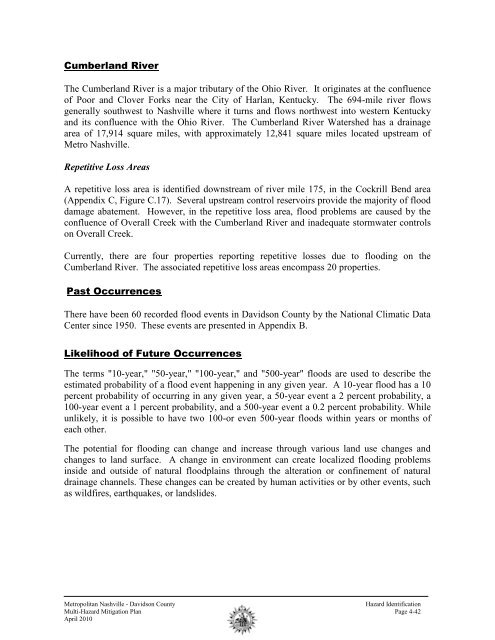2010 Metro Mitigation Plan
2010 Metro Mitigation Plan
2010 Metro Mitigation Plan
You also want an ePaper? Increase the reach of your titles
YUMPU automatically turns print PDFs into web optimized ePapers that Google loves.
Cumberland River<br />
The Cumberland River is a major tributary of the Ohio River. It originates at the confluence<br />
of Poor and Clover Forks near the City of Harlan, Kentucky. The 694-mile river flows<br />
generally southwest to Nashville where it turns and flows northwest into western Kentucky<br />
and its confluence with the Ohio River. The Cumberland River Watershed has a drainage<br />
area of 17,914 square miles, with approximately 12,841 square miles located upstream of<br />
<strong>Metro</strong> Nashville.<br />
Repetitive Loss Areas<br />
A repetitive loss area is identified downstream of river mile 175, in the Cockrill Bend area<br />
(Appendix C, Figure C.17). Several upstream control reservoirs provide the majority of flood<br />
damage abatement. However, in the repetitive loss area, flood problems are caused by the<br />
confluence of Overall Creek with the Cumberland River and inadequate stormwater controls<br />
on Overall Creek.<br />
Currently, there are four properties reporting repetitive losses due to flooding on the<br />
Cumberland River. The associated repetitive loss areas encompass 20 properties.<br />
Past Occurrences<br />
There have been 60 recorded flood events in Davidson County by the National Climatic Data<br />
Center since 1950. These events are presented in Appendix B.<br />
Likelihood of Future Occurrences<br />
The terms "10-year," "50-year," "100-year," and "500-year" floods are used to describe the<br />
estimated probability of a flood event happening in any given year. A 10-year flood has a 10<br />
percent probability of occurring in any given year, a 50-year event a 2 percent probability, a<br />
100-year event a 1 percent probability, and a 500-year event a 0.2 percent probability. While<br />
unlikely, it is possible to have two 100-or even 500-year floods within years or months of<br />
each other.<br />
The potential for flooding can change and increase through various land use changes and<br />
changes to land surface. A change in environment can create localized flooding problems<br />
inside and outside of natural floodplains through the alteration or confinement of natural<br />
drainage channels. These changes can be created by human activities or by other events, such<br />
as wildfires, earthquakes, or landslides.<br />
<strong>Metro</strong>politan Nashville - Davidson County<br />
Hazard Identification<br />
Multi-Hazard <strong>Mitigation</strong> <strong>Plan</strong> Page 4-42<br />
April <strong>2010</strong>


